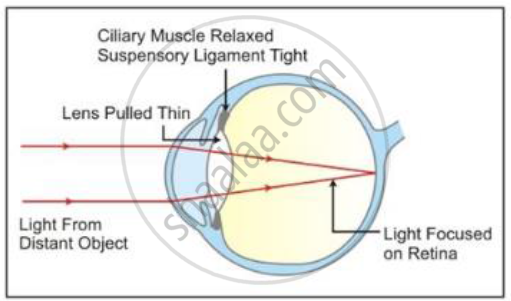Advertisements
Advertisements
Question
Describe the mechanism of focusing the image of a distant object in your eye when you raise your head after reading a book.
Solution 1
While reading a book, the lens is more convex or rounded due to contraction of ciliary muscles because the book is usually read from a short distance. When we raise our head and look at a distant object, the ciliary muscles relax to build the tension on the suspensory ligament so that they can stretch the lens. This change in the curvature of the lens makes us focus on distant object.


Solution 2
The lens is adjusted through accommodation to focus on a distant object while reading. This is a full description:
- Near Vision (Reading a Book):
- Reading causes ciliary muscle contractions in the eyes.
- When the ciliary muscles contract, the suspensory ligaments that support the lens slacken.
- This enables the lens to become more convex or rounded.
- Transition to Distant Vision (Raising Your Head):
- Your ciliary muscles relax when you elevate your head to focus on a distant object.
- Suspensory ligaments pull and flatten the lens.
- The ciliary muscles relax, and the suspensory ligaments strain on the lens.
- Accommodation Power of the Eye:
- Accommodation refers to the process of adjusting focus by modifying the lens shape.
- The eye's accommodation power relies heavily on the ciliary muscles.
- The eye's capacity to concentrate clearly at diverse distances is vital for adapting to various visual tasks.
The ciliary muscles alter the lens shape dynamically, making it convex for near vision and flat for distant vision. The eye's ability to focus clearly at varied distances is due to the process of accommodation.
APPEARS IN
RELATED QUESTIONS
the biological/technical terms for the lens of eye losing flexibility resulting in a kind of long-sightedness in middle aged people.
Name the defect of vision in which the eye-lens loses its power of accommodation due to old age.
What is the other name of old age hypermetropia?
Name one defect of vision (or eye) which cannot be corrected by any type of spectacle lenses.
A man can read the number of a distant but clearly but he finds difficulty in reading a book.
From which defect of the eye is he suffering?
Explain with the help of labelled ray-diagram, the defect of vision called hypermetropia, and hot it is corrected by a lens.
What is short-sightedness? State the two causes of short-sightedness (or myopia). With the help of ray diagrams, show:
(i) the eye-defect short-sightedness.
(ii) correction of short-sightedness by using a lens.
A young man has to hold a book at arm's length to be able to read it clearly. The defect of vision is:
(a) astigmatism
(b) myopia
(c) presbyopia
(d) hypermetropia
Differentiate between members of the following pair with reference to what is asked in bracket.
Myopia and hyperopia (cause of the defect)
Enumerate the common defects of vision, their causes and the possible methods of correcting them.
A person cannot read newspaper placed nearer than 50 cm from his eyes. Name the defect of vision he is suffering from. Draw a ray diagram to illustrate this defect. List its two possible causes. Draw a ray diagram to show how this defect may be corrected using a lens of appropriate focal length.
A student cannot see a chart hanging on a wall placed at a distance of 3 m from him. Name the defect of vision he is suffering from. How can it be corrected? Draw ray diagrams for the (i) defect of vision and also (ii) for its correction.
When do we consider a student sitting in the class to be myopic? List two causes of this defect. Explain using a ray diagram how this defect of eye can be corrected.
Name the following:
The photosensitive pigment present in the rod cells of the retina.
Write whether the following is true or false:
A convex lens is used for correcting myopia.
The near point of the eye of a person is 50 cm. Find the nature and power of the corrective lens required by the person to enable him to see clearly the objects placed at 25 cm from the eye?
Give Reason:
Deficiency of vitamin A causes night blindness.
Write scientific reason.
Nearsightedness, this defect can be corrected by using spectacles with concave lens.
A person needs a lens of power –4.5 D for correction of her vision.
- What kind of defect in vision is she suffering from?
- What is the focal length of the corrective lens?
- What is the nature of the corrective lens?
When do we consider a person to be myopic or hypermetropic? Explain using diagrams how the defects associated with myopic and hypermetropic eye can be corrected?
